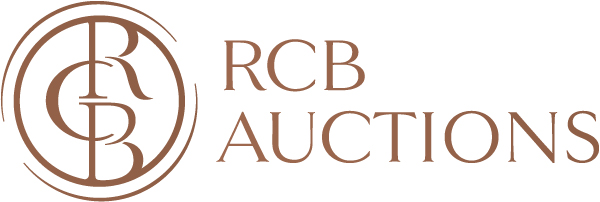A Guide to Benjarong Patterns: Fundamentals
From flower scrolls, lotus flowers, geometrics, mythological creatures, and Hindu-Buddhist deities. Sino-Thai ceramics, or Benjarong, have a variety of complex patterns inherited from Thai art and culture with a mix of inspiration from Chinese and Indian artistic traditions. Plant motifs are the most common decorative design but stylized to form complex geometrics and often symmetrical compositions. RCB auctions dives into 5 principal Thai patterns (Lai) found in Sino-Thai ceramics; Chinese import porcelain decorated with Thai patterns.
1. Flower Scrolls ‘Karn Tor Dok’

A benjarong multi-tiered lidded jar decorated with floral design on a gold background. Thai. Rattanakosin. 19th. Sold at RCB auctions for THB 260,000.
‘Lai Karn Tor Dok’ is one of the more common patterns in benjarong design. It is a fundamental motif that first appeared in the late Ayutthaya period (1350 - 1767). Each flower is outlined from the center of the benjarong and is perfectly painted on top of each other forming a continuous straight-line of floral vine scrolls/branches. This is vertically repeated around the whole outer exterior of the benjarong covering most of the background space.
The benjarong above ‘Karn Chor Dok’ is a slight variation that features a combination design of ‘Karn Tor Dok’ and diamond-shaped frames. Leafy foliate branches from each flower create a continuous trellis cross around the benjarong, giving the design a geometrical appearance. Choice of flowers vary but many are inspired by the flowers of the Himaphan forest, the five sacred flowers found in the mythological forest believed to be below the heaven. Pikul is the flower used for the benjarong above.
2. Trellis and Rice ‘Lai Phum Khao Bin’

A Benjarong multi-tiered lidded jar painted and gilt with a continuous of trellis pattern on a gold ground. Thai, Rattanakosin.19th. Sold at RCB auctions for THB 600,000
A popular pattern especially for later benjarong ware, ‘Lai Phum Khao Bin’ dates to the Sukhothai period (1238 - 1438), but first appeared on benjarong in the late Ayutthaya period (1350 - 1767) and developed into different styles at the beginning of the Rattanakosin period (1782 - 1932).
This geometrical trellis pattern features leaves and flowers. The leaves and vines form diamond shape frames around the benjarong and inside is a stylized flower with three spiky petals and a stem, the shape of the flower is inspired by the lotus flower. The word ‘Phum’ means bush and ‘Khao Bin’ is a term historically used for rice offerings molded into a lotus shape for the gods or monks.
3. Lotus Flowers ‘Lai Dok Kleep Bua’

A large Benjarong dish painted with floral designs within lotus petal panels. Thai, Rattanakosin. 19th. Sold at RCB auctions for THB 90,000
The lotus flower is a greatly used motif in Thai art because the flower is a sacred symbol of Buddhism. Blooming above dark muddy waters the meaning of the lotus signifies purity, creation, serenity, and the path to enlightenment.
The Thai stylized lotus is straight and clear-cut, akin to other Thai designs which are focused on geomatical shapes and symmetry. Open Lotus flower petals ‘Lai Dok Kleep Bua’ is often painted on benjarong stem trays because the shape of the stem trays appears like a bloomed flower bud with an extended stalk. In the stem tray above, the petals are painted encircling the exterior and interior above the stem while in the center is a lotus medallion and decorated with foliate scrolls at the rim. Within each lotus petal panel is the fundamental floral motif ‘Karn Tor Dok’.
4. Deities and Mythological Creatures ‘Lai Thepphanom’

A rare and fine benjarong covered bowl painted with Thepphanom on a turquoise ground alternating with Narasingha. Thai, Rattanakosin. 19th. Sold at RCB Auctions for THB 550,000
‘Lai Thepphanom’ first appeared in the late Ayutthaya period (1350 - 1767), Thepphanom are minor deities adopted from Hinduism and Buddhism. In many pieces, Thepphanom appears in a praying posture alternating with mythological creatures from the Himaphan forest such Narasingha, Garuda, or Rajasinhha. The background is either painted with ‘Kranok’, a popular Thai stylized rendition of a flame-like motif, or twisting vines, ‘Lai Kan Khod’.
In the bowl above the Thepphanom is depicted in praying posture on a lotus bed, alternating with Narasingha, a half-man (Nara) half-lion (Singha). In India, a Narasingha has a lion face and a human body but in Thai iconography, they appear with a human face and lion body. The patterns are religious in nature, symbolizing the Royal family's divinity and acting as protection for the king. The kings of the Rattanakosin period practiced the Indian concept of Devaraja and are titled Rama after the incarnation of the Hindu god Vishnu. So, these patterns were commissioned exclusively as royal ware.
5. Twisting Vines Scroll ‘Lai Kan Khod’

A benjarong (Lai Nam Thong) covered jarlet painted with twisting vine scrolls. Thai, Rattanakosin. 19th
This scroll design is a naturalistic motif of vines and leaves. Each vine spirals into swirling circles forming fluid curves around the benjarong. The vine scroll is a very universal tradition, but the Thai twisting vines scroll has many distinct characteristics; they are painted with colorful pigments and the combination of other elements like the ‘Kanok’ design is sometimes used as leaves.
In the bowl above, it is used as a principal pattern, but twisting vine scroll design is used more commonly as a secondary decorative pattern such as background filler for Thepanom patterns or as a narrow band for border decoration.
Further Reading
Robinson, N. V. (1985). Sino-Thai Ceramics, Siam Society
อว์นเอฟ. รูนีย์ (2017) เครื่องถ้วยเบญจรงค์และลายนาทองดอว์, River Books

